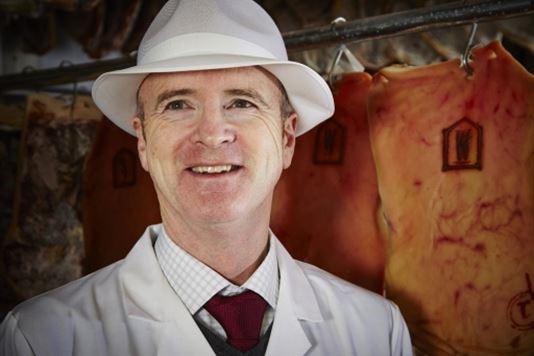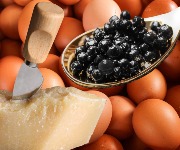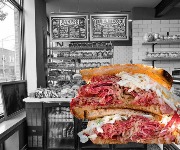loveFOOD meets… a master curer

British shoppers have taken to charcuterie in a big way. We talk to Colin Woodall, master curer at Woodall’s, creators of world-class charcuterie for nearly two centuries.
‘The gentleman who paid the rent’
The Woodall family began curing pork in 1828 in Waberthwaite, Cumbria, when current master curer Colin’s great-great-great-great-great grandmother Hannah, a young widow at the time, used her farmhouse butchery and curing skills to offer a range of products for villagers to enjoy. The meat she produced would sustain local families throughout the long winter months.
At that time, almost all country households kept a pig (commonly known as ‘the gentleman who paid the rent’), and in October or November the animal would be slaughtered and the carcase turned into as many different products as possible. Once cured, the produce, including joints of ham and sides of bacon, would be hung from the farmhouse kitchen ceiling to dry. A little known fact is that Cumberland sausage was also hung, and consequently eaten in the same way as salami is today.
A continuing tradition
 “Producing charcuterie is often thought of as a continental tradition,” says Colin. “But in Britain, this method of preserving meat was widespread until the 1900s. That it became less popular is due, in my opinion, to the Industrial Revolution and urbanisation, which resulted in the loss of many traditional culinary skills. This was compounded by the arrival of more convenient methods of preservation such as canning and, later, refrigeration and freezing.”
“Producing charcuterie is often thought of as a continental tradition,” says Colin. “But in Britain, this method of preserving meat was widespread until the 1900s. That it became less popular is due, in my opinion, to the Industrial Revolution and urbanisation, which resulted in the loss of many traditional culinary skills. This was compounded by the arrival of more convenient methods of preservation such as canning and, later, refrigeration and freezing.”
From humble beginnings, Woodall’s went on to feature on such august menus as the Titanic and Concorde, as well as fuelling several Everest ascents and achieving the Royal Warrant in 1990.
Today, Woodall’s uses the same family recipes, curing and smoking techniques that have been handed down through the generations. It’s not just a take on continental charcuterie, it’s truly, authentically British.
Woodall’s flagship Royal Ham, for example, is adapted from an old Suffolk recipe. It’s pickled in a rich blend of Timothy Taylor’s Landlord Pale Ale, molasses, vinegar and brown sugar before being lightly smoked. The result is a totally unique air-dried ham with a wonderfully complex, rich, sweet flavour and melt-in-the mouth texture.
The Woodall’s range also includes: air-dried Cumbrian ham (their original air-dried ham, traditionally hand cured for six months using the Woodall family recipe); air-dried smoked pancetta (matured over 55 days to make it perfect for cooking); and a deep, rich Cumberland salami, originating from the Cumberland sausage recipe that the Woodall family used for eight generations.
How it’s done
 Dry curing works by hand-rubbing curing salts into the meat. Over time, the salt slowly draws the moisture out of the meat to create a brine. The latter then seeps back into the meat, filling the now empty cells with salt so there isn’t enough water left in the meat for bacteria to survive. And so the meat is preserved.
Dry curing works by hand-rubbing curing salts into the meat. Over time, the salt slowly draws the moisture out of the meat to create a brine. The latter then seeps back into the meat, filling the now empty cells with salt so there isn’t enough water left in the meat for bacteria to survive. And so the meat is preserved.
"Once the salting process is complete, the meat is washed off and hung up to air dry. Obviously today we carefully control the amount of salt that’s used and, instead of the kitchen ceiling, we have special temperature and humidity controlled chambers where the pork is hung and gently dried," Colin says.
"The longer the ham is hung for, the more the flavour develops. The secret ingredient is time – our air-dried ham still takes a minimum of six months to make, and a great deal of patience!"
Woodall’s products now feature on British Airways and Virgin Atlantic, and are also available at leading delicatessens and supermarkets such as Booths and Waitrose. For more information, visit woodallscharcuterie.co.uk.
You might also like
Most Recent
Comments
Be the first to comment
Do you want to comment on this article? You need to be signed in for this feature








